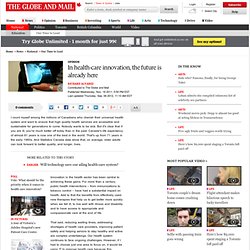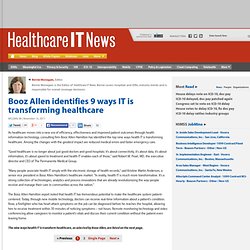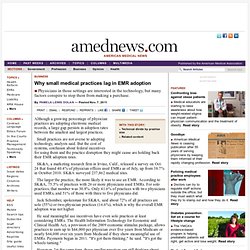

In health-care innovation, the future is already here. I count myself among the millions of Canadians who cherish their universal health system and want to ensure that high quality health services are accessible and sustainable for generations to come.

Nobody wants to be sick. But it’s clear that if you are ill, you’re much better off today than in the past. Canada’s life expectancy of almost 81 years is now one of the best in the world. That’s up from 71 years in the early 1960s. And Statistics Canada data show that, on average, older adults can look forward to better quality, and longer, lives. Innovation in the health sector has been central to achieving these gains. That said, reducing waiting times, addressing shortages of health care providers, improving patient safety and helping seniors to stay healthy and active are complex undertakings. Take waiting times. Access to care is also aided by telehealth, particularly in rural and remote communities. Booz Allen identifies 9 ways IT is transforming healthcare. As healthcare moves into a new era of efficiency, effectiveness and improved patient outcomes through health information technology, consulting firm Booz Allen Hamilton has identified the top nine ways health IT is transforming healthcare.

Among the changes with the greatest impact are reduced medical errors and faster emergency care. "Good healthcare is no longer about just good doctors and good hospitals; it's about connectivity, it's about data, it's about information, it's about speed to treatment and health IT enables each of those," said Robert M. Pearl, MD, the executive director and CEO of The Permanente Medical Group. "Many people associate health IT simply with the electronic storage of health records," said Kristine Martin Anderson, a senior vice president in Booz Allen Hamilton's healthcare market. "In reality, health IT is much more transformative. The nine ways health IT is transform healthcare, as selected by Booz Allen, are listed on the next page. National Broadband Plan - Chapter 10: Healthcare.
Inside this Chapter Improving Americans’ health is one of the most important tasks for the nation.

Health care already accounts for 17% of U.S. gross domestic product (GDP); by 2020, it will top 20% .1 America is aging— by 2040, there will be twice as many Americans older than 65 as there are today—and health care costs will likely increase as a consequence. Rising costs would be less concerning if there were results. But Americans are not healthy. Sixty-one percent of American adults are overweight or obese, which often leads to medical complications.2 Chronic conditions, which already account for 75%3 of the nation’s health care costs, are increasing across all ages.4 The nation has 670,000 new cases of congestive heart failure every year, many of them fatal.5 And too often the care itself causes harm. In addition, the United States has a health care supply problem.
Broadband is not a panacea. This chapter’s recommendations aim to encourage maximum utilization of these solutions. Why small medical practices lag in EMR adoption. Although a growing percentage of physician practices are adopting electronic medical records, a large gap persists in adoption rates between the smallest and largest practices.

Small practices are not averse to adopting technology, analysts said. But the cost of systems, confusion about federal incentives for using them and the practice disruption they might cause are holding back their EMR adoption rates. SK&A, a marketing research firm in Irvine, Calif., released a survey on Oct. 24 that found 40.4% of physician offices used EMRs as of July, up from 38.7% in October 2010. SK&A surveyed 237,862 medical sites. The larger the practice, the more likely it was to use an EMR. Jack Schember, spokesman for SK&A, said about 72% of all practices are solo (55%) or two-physician practices (16.6%), which is why the overall EMR adoption was not higher.
He said meaningful use incentives have even solo practices at least considering EMRs. The purchase price is not the only issue. Impact of the RECs.